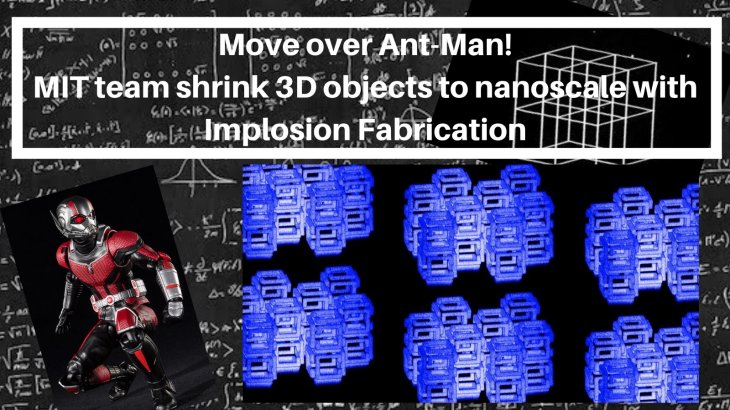MIT Scientists Found A New Technique To Shrink 3D Objects To The Nanoscale
Jyotis - Dec 15, 2018

The latest invention is showing the high potentials in the variety of fields, including medicine, robotics, and optics.
- Unveiling Tomb Of Romulus, The King Who Was Raised By Wolves
- This Is The Most Gigantic 3D-Printed Building In The World
- This Tool Of Nvidia Can Create 3D Models From 2D Pictures
The scientists from MIT have found a new technique called “implosion fabrication” to shrink almost all of 3D objects to the nanoscale. The latest invention is showing the high potentials in the variety of fields, including medicine, robotics, and optics.
In the journal Science, research reveals that the new technique has the diverse applicability scope, and it can be applied to handle the objects made from metals, DNA, as well as quantum dots.
According to Edward Boyden, the technique can reach the accuracy up to nanoscale. For those unknown, he is working as an associate professor at the US’s Massachusetts Institute of Technology.
To design any structure and shape as desired, the scientists can use a laser to pattern a polymer scaffold. After other materials are attached to the scaffold, they shrink the prototype to the new dimensions that are one thousandth over the first object’s ones.
 Will we have more Ant-Men with the latest technique, won't we?
Will we have more Ant-Men with the latest technique, won't we?
The most exciting thing in this technique is that it can be available in a lot of labs of materials science and biology. That means any researcher across the world will have a chance to conduct the experiment with it.
As we can see, current techniques applied to create nanostructures have many limits. For example, you can use light to etch patterns on any surface and make nanostructures in 2D shape; however, this way is worthless to 3D structures.
There is a solution to produce 3D nanostructures: overlaying many layers onto the original surface until the finish may reach our satisfaction. However, this process is said to waste time and be difficult to implement.
Besides, the existing techniques to create objects in the 3D nanoscale can only be applied to some specific materials such as plastics or polymers, whose functional properties don’t meet the requirements of some applications.
Among them, the expansion microscopy (ExM) technique enables researchers to embed tissues into a hydrogel to enlarge it. This aims to show high-resolution images, even when seen via an ordinary microscope.
The researchers have reversed this process to reduce the objects’ size to the nanoscale. An absorbent material is chosen as a scaffold that put into a solution containing fluorescein molecules. And then, when laser light is in contact with these molecules, they will be triggered and sticky to the scaffold.
Next, the researchers use two-photon microscopy to impact on the points lying deep inside the objects’ structure and apply the specialized gel into some location to stick the molecules of fluorescein. After that, the molecules will become anchors to attach to other molecules added by the researchers.
Featured Stories

Features - Jul 01, 2025
What Are The Fastest Passenger Vehicles Ever Created?

Features - Jun 25, 2025
Japan Hydrogen Breakthrough: Scientists Crack the Clean Energy Code with...

ICT News - Jun 25, 2025
AI Intimidation Tactics: CEOs Turn Flawed Technology Into Employee Fear Machine

Review - Jun 25, 2025
Windows 11 Problems: Is Microsoft's "Best" OS Actually Getting Worse?

Features - Jun 22, 2025
Telegram Founder Pavel Durov Plans to Split $14 Billion Fortune Among 106 Children

ICT News - Jun 22, 2025
Neuralink Telepathy Chip Enables Quadriplegic Rob Greiner to Control Games with...

Features - Jun 21, 2025
This Over $100 Bottle Has Nothing But Fresh Air Inside

Features - Jun 18, 2025
Best Mobile VPN Apps for Gaming 2025: Complete Guide

Features - Jun 18, 2025
A Math Formula Tells Us How Long Everything Will Live

Features - Jun 16, 2025

 Or more Alices?
Or more Alices?
Comments
Sort by Newest | Popular